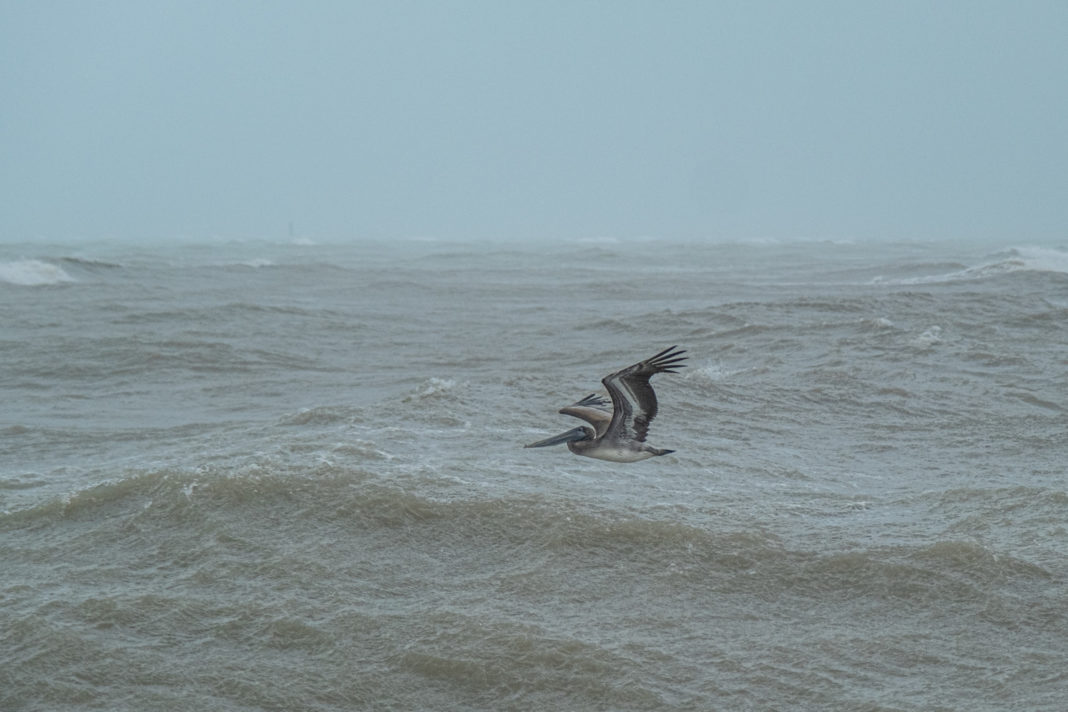I was out at the end of White Street Pier, trying to figure out how to use a GoPro in burst mode, when the feeder bands were hitting. The waves were slamming straight into the end of the pier, as they usually do in heavy weather, and creating volcanic explosions of white foam that people of an adventurous nature like to get blasted by. Everyone out there was getting knocked around – even people just trying to take pictures a few feet back from the full brunt of it – and we were all pretty much blinded by the wind and the saltwater. Between the waves hitting all you could hear was laughter.
I didn’t end up getting any great shots, but I got a couple I liked. One was of my friend DJ in a blue tutu ensemble, a small figure about to be subsumed by a massive wall of froth. Another is of DJ and his friend Emma in matching vrksasana/tree poses as the water curls up behind them.
I’d seen a couple laughing gulls and royal terns sliding by overhead, local birds that never seem bothered by much of anything, the kind I’ve seen flying in the worst of storms. But the brown pelican caught my eye as I was leaving. It was out in the zone between the pier and West Martello, which was something of a no-man’s land during the storm. The bird mostly sat there, rocking on the waves, but then would get up occasionally, and fly slowly forward on an upwind reach. And then it would plop down into the water quickly and without warning and from not much of a height. I think it was feeding, but pelicans find their prey by sight, usually from a much greater height, and the water was all whitecaps and churn, so I’m not sure what kind of success it was having, and whether the limited results were worth the heightened risk. The bird seemed so alone out there in all that chaos, but the shore, a place of greater safety, was just a short, downwind ride away. I hoped it would head that way before the storm got much worse.
Birds generally know how to survive in rough weather. Not always — Hurricane Maria killed off more than half the population of the already critically endangered Puerto Rican parrot — but most of the time. It is thought that most birds just retreat to the interiors of trees and bushes and other places out of the wind. But it is an understudied subject, largely because as severe weather events take place, scientists are generally not out with clipboards collecting data, but instead seeking safety like everyone else. New technologies in recent years have provided some insight, though.
Birds, it seems, have two basic strategies for surviving storms: ride it out, or don’t be there. Avoiding an area is a strategy generally taken up by migrating birds. When they feel the atmospheric pressure drop and the winds come, it seems they will often just pause their migration until the storm passes and weather conditions are favorable again.
Ornithologists at Clemson University published a paper in 2019 using data from GPS transmitters attached with backpack-like harnesses to 32 brown pelicans from multiple colonies. They tracked them through a series of three hurricanes. They found that the pelicans tended to heavily limit their movements and take shelter on barrier islands and in estuaries, where wave action is usually diminished.
The folks at the Avian Research and Conservation Institute, based out of Gainesville, found similar results tracking six reddish egrets through Hurricane Irma in 2017 – the birds retreated to sites such as barrier islands and to inland ponds, generally taking shelter in the dense mangrove habitats.
Researchers at the College of William & Mary have had more varied and dramatic results satellite tracking whimbrels – largish shorebirds and long distance migrants who will often fly thousands of miles non-stop over the ocean. One was tracked flying south from Hudson Bay, then off the Eastern Seaboard, and then directly into the northwest quadrant of a Category 3 storm, disappearing at first, but then reappearing 48 hours later in the Bahamas. Another tracked whimbrel encountered a storm off Nova Scotia and flew within it for 27 hours, surviving winds up to 90 mph before being redeposited on the continent on Cape Cod. A third whimbrel flew into a storm, but did not survive.
It’s been known for a long time that storms will also push birds ahead or along with them. In the aftermath of hurricanes that veered inland, tropical pelagic species such as magnificent frigatebirds and sooty terns have regularly been reported in small numbers as far away from the Caribbean as Wisconsin, Minnesota, Colorado and Ontario.
Sailors at sea during hurricanes have often reported seeing large flocks of birds trapped in the eyes of the storms. But in recent years scientists have witnessed the phenomenon using weather radar. As of yet they can’t detect as to numbers or species, but the technology may eventually get there.
In 2005, Hurricane Wilma, after it was done flooding Key West, went on to entrap a large flock of chimney swifts farther up the Eastern Seaboard, carrying many of them over to Western Europe. The flock was so large that in the years following, the chimney swift population in the province of Quebec was thought to be only half what it was before the storm.
When I got home from the pier the other night, there was a flock of about two dozen mourning doves sitting quietly on the back deck in the lee of our fence. I thought, all right guys, let’s ride this out together. But when I looked out an hour later they were all gone.
I’m just going to assume they went somewhere safe.
























